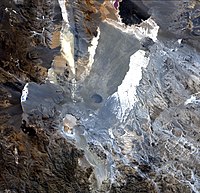
Photo from wikipedia
Travertine crystal growth ripples are used to reconstruct the early hydraulic history of the Anio Novus aqueduct of ancient Rome. These crystalline morphologies deposited within the aqueduct channel record the… Click to show full abstract
Travertine crystal growth ripples are used to reconstruct the early hydraulic history of the Anio Novus aqueduct of ancient Rome. These crystalline morphologies deposited within the aqueduct channel record the hydraulic history of gravity-driven turbulent flow at the time of Roman operation. The wavelength, amplitude, and steepness of these travertine crystal growth ripples indicate that large-scale sustained aqueduct flows scaled directly with the thickness of the aqueous viscous sublayer. Resulting critical shear Reynolds numbers are comparable with those reconstructed from heat/mass transfer crystalline ripples formed in other natural and engineered environments. This includes sediment transport in rivers, lakes, and oceans, chemical precipitation and dissolution in caves, and melting and freezing in ice. Where flow depth and perimeter could be reconstructed from the distribution and stratigraphy of the travertine within the Anio Novus aqueduct, flow velocity and rate have been quantified by deriving roughness-flow relationships that are independent of water temperature. More generally, under conditions of near-constant water temperature and kinematic viscosity within the Anio Novus aqueduct channel, the travertine crystal growth ripple wavelengths increased with decreasing flow velocity, indicating that systematic changes took place in flow rate during travertine deposition. This study establishes that travertine crystal growth ripples such as those preserved in the Anio Novus provide a sensitive record of past hydraulic conditions, which can be similarly reconstructed from travertine deposited in other ancient water conveyance and storage systems around the world.
Journal Title: Scientific Reports
Year Published: 2022
Link to full text (if available)
Share on Social Media: Sign Up to like & get
recommendations!